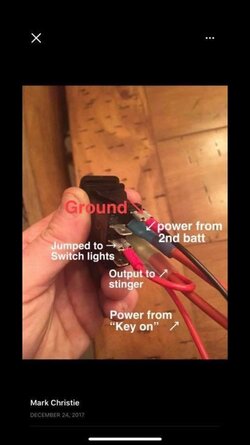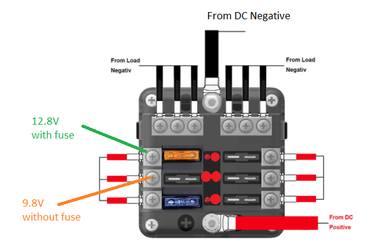Hondasxs
Club Founder
Staff member
Lifetime Member
Supporting Member
Safer then some of the installs I have seen.
Sent from my SM-G996U using Tapatalk
Safer then some of the installs I have seen.
As @ACfixer mentioned - the main concern and reason I used the DPDT switch in the example is due to the potential for leaking current for accessories that are "sort of on" and lightly draining battery without intentionally being on. I'm not smart enough to know exactly how or why a specific configuration "should work", like a SPDT switch instead, but I like to err on the side of being certain that everything is isolated to avoid any leaking current draw. I want a "definitely everything is off and isolated" position on the switch. So the SPDT should work - but I personally prefer the "definitely all off" position.SO, lets talk about switches and relays again...
@RobSparre in your *v301.pdf schematic you use a DPDT switch to toggle between key-on and always-on power source, with "off" being the middle position. I couldn't think of one scenario where I would not want power to all my accessories. This brought be back to relays, specifically the SPDT relay.
The SPDT has a common terminal, a normally closed (NC) terminal, and normally open (NO) terminal. The key-on power would be wired to the NC leg and the always-on to the NO side. A simple on/off switch would energize the coil, breaking contact with the NC (key-on) terminal and switching to the NO (always-on) terminal, thus eliminating the "all off" position using a regular DPDT switch.
Does anyone see a problem with using the SPDT relay as opposed to a DPDT switch to control the accessory power source? I'm beginning to layout my wiring and this was the only piece to the schematic that had me puzzled.
As @ACfixer mentioned - the main concern and reason I used the DPDT switch in the example is due to the potential for leaking current for accessories that are "sort of on" and lightly draining battery without intentionally being on. I'm not smart enough to know exactly how or why a specific configuration "should work", like a SPDT switch instead, but I like to err on the side of being certain that everything is isolated to avoid any leaking current draw. I want a "definitely everything is off and isolated" position on the switch. So the SPDT should work - but I personally prefer the "definitely all off" position.
I am little confused on the DPDT switch wiring. Care to break that down for me and which switch you purchased? Please.
The switches I see for diagrams show the power going to "both" sides of switch. Same power? I don't see how it separates the power going into the Stinger for option of key on power vs all power if switch is on "other" side?
Can you show how you wired the DPDT switch?
View attachment 290648View attachment 290649
See if this helps. I’m not sure about your ? But it sounds like your trying to wire a master switch to control the stinger. This is a seven pin maintained on off on.I am little confused on the DPDT switch wiring. Care to break that down for me and which switch you purchased? Please.
The switches I see for diagrams show the power going to "both" sides of switch. Same power? I don't see how it separates the power going into the Stinger for option of key on power vs all power if switch is on "other" side?
Can you show how you wired the DPDT switch?
View attachment 290648View attachment 290649

The switch I am showing has 2 power input connections, both on the left side. The top left says "key-on accessory power". That means it will come from either a key-on harness or accessory fuse #5 from the main fuse box. It will not have power unless the stinger is energized and there is power to the aux fuse box. This is the way I wired mine and demonstrated in the video.I am little confused on the DPDT switch wiring. Care to break that down for me and which switch you purchased? Please.
The switches I see for diagrams show the power going to "both" sides of switch. Same power? I don't see how it separates the power going into the Stinger for option of key on power vs all power if switch is on "other" side?
Can you show how you wired the DPDT switch?
View attachment 290648View attachment 290649
Yes, for that switch your diagram should be correct.Awesome! I believe I understand it now. THANK YOU for your help!!
So it's basically reversing the input/output of the switch. So what would normally be the output power to 2 different devices, is now actually the input of 2 different power in and 1 single power out to engage the Stinger relay.
I don't have any switches yet. Just ordered the True isolator, extra battery, radio/speakers, fuse block, winch, blinker kit that I want to power all up via the 2nd battery.
View attachment 290826
Yes - very good summary - you’ve got it! Let us know how it turns out.Awesome! I believe I understand it now. THANK YOU for your help!!
So it's basically reversing the input/output of the switch. So what would normally be the output power to 2 different devices, is now actually the input of 2 different power in and 1 single power out to engage the Stinger relay.
I don't have any switches yet. Just ordered the True isolator, extra battery, radio/speakers, fuse block, winch, blinker kit that I want to power all up via the 2nd battery.
View attachment 290826
Wow that looks fantastic - great job!! Very creative with component locations and very clean. Feels good to complete a job like that doesn’t it?Just wanted to say thanks for the help in this thread (and forum) Everybody has been helpful! The dual switch (key/constant) for power idea is great and wouldn't have thought of that on my own!
Finished up installing extra battery, isolator, stinger relay, fuse block, winch, dash plate and switches (made my own from left over plastic and 3m carbon fiber sticker), radio, speaker pods, blinker kit, and whatever else I can't remember. Been a solid week of working on it in the evenings after work. Took it out for a spin today and enjoyed it down at the creek with the whole family!
I'm sure it could be a cleaner install, but I did it all myself. Maybe I'll clean it up more later, or maybe I'll just go enjoy it!
View attachment 292276View attachment 292277
Thanks for the feedback and enjoy your project - it is very satisfying to the soul to do this! Very smart to ask if any changes in thinking since the video.Great video. Found it quite informative and was helpful in figuring out the necessary components to perform this task as well as placement of the components. I do have a couple questions however. Does the dual volt meter that comes with the True kit fit the switch plate hole or did you have to modify the switch plate to make it fit? Have you found a need for more switches than the original plate you installed which I believe was 5 switches with two different power adapters and the volt meter? Are you still adding accessories to the fuse box you purchased or is the six fuse enough? I'm in the process of ordering everything for a second battery install in my machine and was just wondering what you would do different now, from what you originally did. Thanks in advance.



